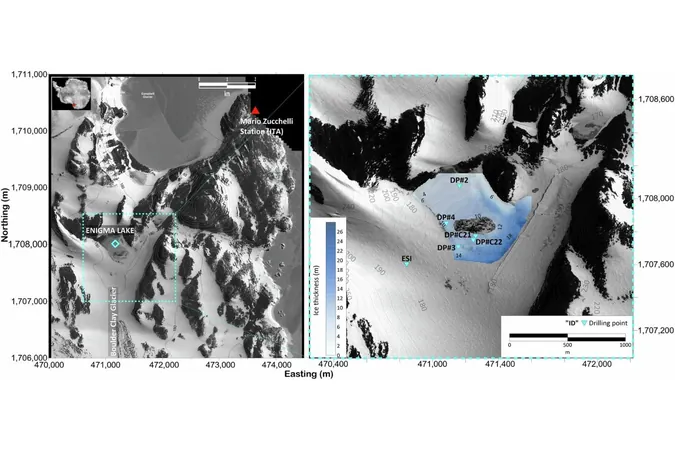
Unearthed: Ancient Microbial Life Thrives in Hidden Antarctic Lake!
2024-12-06
Author: Ying
Unearthed: Ancient Microbial Life Thrives in Hidden Antarctic Lake!
Have you ever pondered what hidden secrets lie beneath the ancient ice of Antarctica? Researchers have made a groundbreaking discovery at a site aptly named Lake Enigma, where unique microbial communities are surviving beneath a thick veil of ice. This astonishing finding gives us a glimpse into a previously unknown ecosystem that challenges our understanding of life in extreme environments.
An international team of polar scientists recently published their jaw-dropping research in the journal *Communications Earth & Environment*. They found that Lake Enigma, located between the Amorphous and Boulder Clay glaciers in Antarctica’s Northern Foothills, is not as desolate as one might think. Despite temperatures averaging a frigid 6.8°F (-14°C) and plunging to lows of -41.26°F (-40.7°C), evidence suggests that a thriving microscopic world exists beneath the ice.
During the 2019 and 2020 summer seasons, these researchers, including experts from Italy’s Institute of Polar Sciences, made a shocking discovery: Lake Enigma is not completely frozen. Utilizing advanced ground-penetrating radar technology, they detected a reservoir of liquid water approximately 36 feet (11 meters) beneath the ice, with depths reaching a maximum of 39.4 feet (12 meters).
To probe this hidden aquatic world, the team carefully drilled through the ice, employing contamination-free techniques to avoid tainting their precious samples. What they uncovered was extraordinary—a vibrant array of microorganisms. They cataloged various bacteria, notably species from the Pseudomonadota, Actinobacteriota, and Bacteroidota groups. Strikingly, the samples also revealed a predominance of ultrasmall bacteria from the enigmatic superphylum Patescibacteria, marking a fascinating new chapter in the understanding of Antarctic microbiomes.
These findings point to a complex web of life that once flourished in Lake Enigma prior to its freezing. While the specific timeline of when the lake ceased to be habitable remains uncertain, evidence shows that Antarctica as a whole became an icy wilderness roughly 14 million years ago. This timeline suggests that the isolated microbes today may be descendants of an ancient lineage that has adapted to extreme conditions over millions of years.
Interestingly, the team theorizes that since Lake Enigma still contains liquid water, it may have an undiscovered source, likely fed by the nearby Amorphous Glacier. However, the lake remains shielded from the harsher realities of the outside world, featuring a chemically layered water column that indicates minimal external influence.
The significance of these microorganisms extends well beyond mere curiosity. Their resilience offers profound insights into life in extreme environments—information that could hold key implications for astrobiology and our quest to understand life beyond Earth. Moreover, these findings remind us of the ancient ecosystems that once thrived on a continent that today seems barren, opening up new avenues for exploration and understanding.
In conclusion, the discovery of life in such remote and inhospitable locations like Lake Enigma underscores the incredible adaptability of microorganisms—and invites us to ponder the hidden life forms waiting to be uncovered across our planet. What other mysteries does Antarctica conceal? The adventure of discovery is just beginning!

 Brasil (PT)
Brasil (PT)
 Canada (EN)
Canada (EN)
 Chile (ES)
Chile (ES)
 Česko (CS)
Česko (CS)
 대한민국 (KO)
대한민국 (KO)
 España (ES)
España (ES)
 France (FR)
France (FR)
 Hong Kong (EN)
Hong Kong (EN)
 Italia (IT)
Italia (IT)
 日本 (JA)
日本 (JA)
 Magyarország (HU)
Magyarország (HU)
 Norge (NO)
Norge (NO)
 Polska (PL)
Polska (PL)
 Schweiz (DE)
Schweiz (DE)
 Singapore (EN)
Singapore (EN)
 Sverige (SV)
Sverige (SV)
 Suomi (FI)
Suomi (FI)
 Türkiye (TR)
Türkiye (TR)
 الإمارات العربية المتحدة (AR)
الإمارات العربية المتحدة (AR)